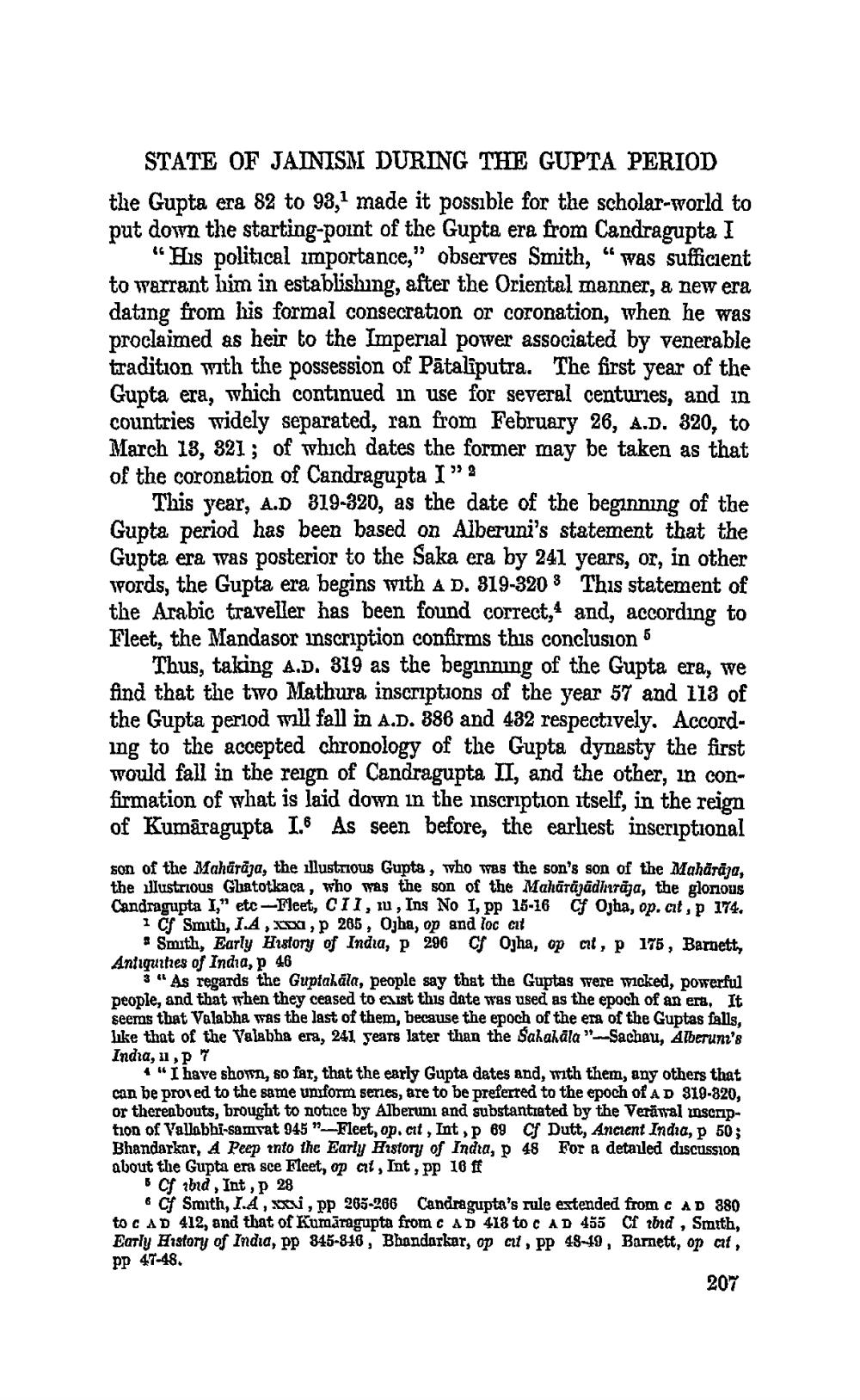________________ STATE OF JAINISM DURING THE GUPTA PERIOD the Gupta era 82 to 93,1 made it possible for the scholar-world to put down the starting point of the Gupta era from Candragupta I "His political importance," observes Smith, "was sufficient to warrant him in establishing, after the Oriental manner, & new era dating from his formal consecration or coronation, when he was proclaimed as heir to the Imperial power associated by venerable tradition with the possession of Pataliputra. The first year of the Gupta era, which continued in use for several centuries, and in countries widely separated, ran from February 26, A.D. 820, to March 18, 321 ; of which dates the former may be taken as that of the coronation of Candragupta I" This year, A.D 319-320, as the date of the beginning of the Gupta period has been based on Alberuni's statement that the Gupta era was posterior to the Saka era by 241 years, or, in other words, the Gupta era begins with A D. 819-320 % This statement of the Arabic traveller has been found correct, and, according to Fleet, the Mandasor inscription confirms this conclusion Thus, taking A.D. 319 as the beginning of the Gupta era, we find that the two Mathura inscriptions of the year 57 and 118 of the Gupta period will fall in A.D. 886 and 432 respectively. Accord ing to the accepted chronology of the Gupta dynasty the first would fall in the reign of Candragupta II, and the other, in confirmation of what is laid down in the inscription itself, in the reign of Kumaragupta I. As seen before, the earliest inscriptional son of the Maharaja, the illustrous Gupta, who was the son's son of the Maharaja, the illustrious Ghatotkaca , who was the son of the Maharajadinraja, the glonous Candragupta I," etc-Fleet, CII, IU , Ins No I, pp 16-16 C Ojha, op.at , p 174. IC Smith, I.A, XXX, 205, Ojba, op and loc cut #Smith, Early History of India, P 296 Ojha, op cit, p 175, Barnett, Antiquities of India, p 46 3 "As regards the Guptakala, people say that the Guptas were wicked, powerful people, and that when they ceased to exist thuis date was used as the epoch of an ers. It seems that Valabha was the last of them, because the epoch of the era of the Guptas falls, like that of the Valabha era, 241 years later than the Sahahala "-Sachau, Alberuni's India, 11,P 7 4 "I have shown, so far, that the early Gupta dates and, with them, any others that can be proved to the same uniform series, are to be preferred to the epoch of A D 819-820, or thereabouts, brought to notice by Alberuni and substantiated by the Verawal mscription of Vallabhi-samvat 945"-Fleet, op.cit, Int ,p 69 Cf Dutt, Ancient Indra, 50, Bhandarkar, A Peep into the Early History of Indra, P 48 For a detailed discussion about the Gupta era sce Fleet, op art, Int , PP 16 ff 6 Cf bid Int ,p 28 & C Smith, I.A , xxx, pp 205-206 Candragupta's rule extended from C AD 380 toCAD 412, and that of Kumaragupta from CAD 418 to CAD 455 Cf abd , Smath. Early History of India, Pp 845-816, Bhandarkar, op cut , PP 48-49, Barnett, op af, PP 47-48. 207




